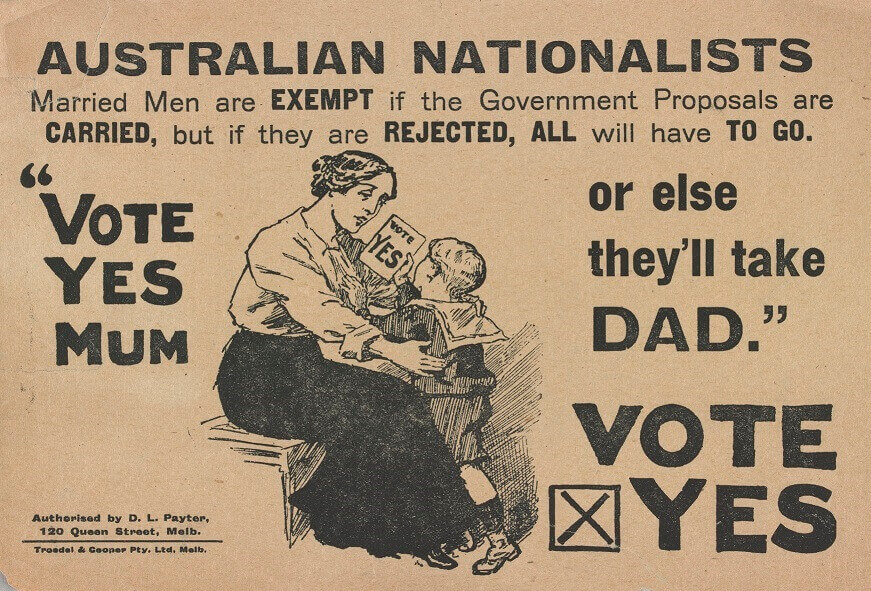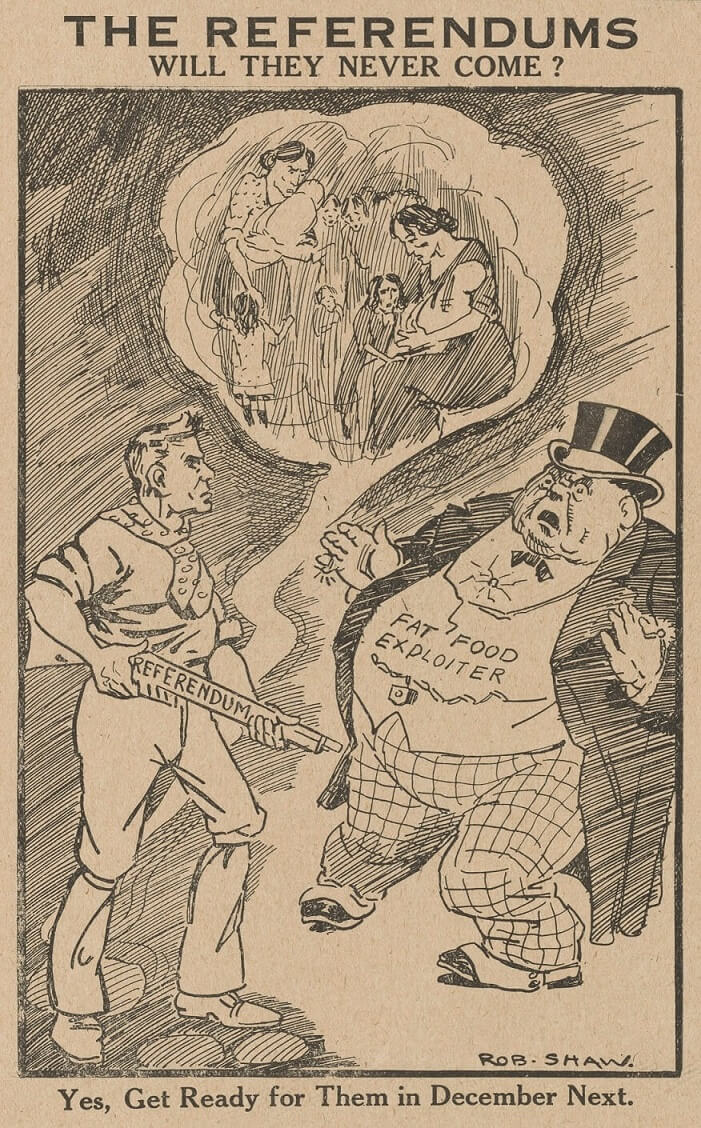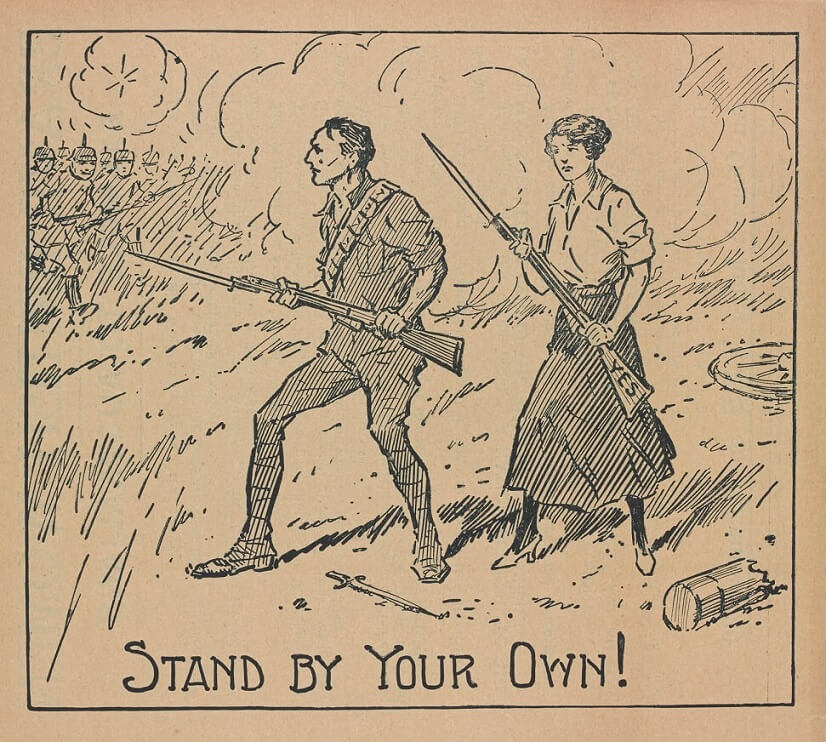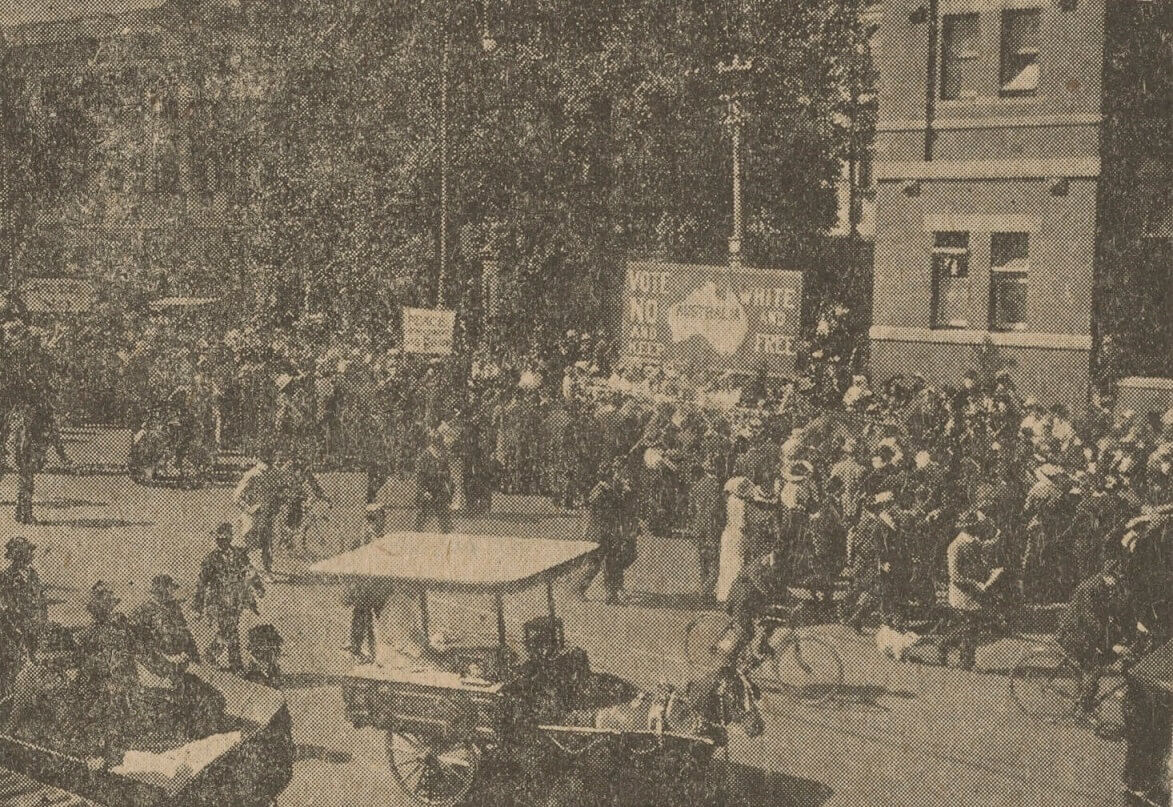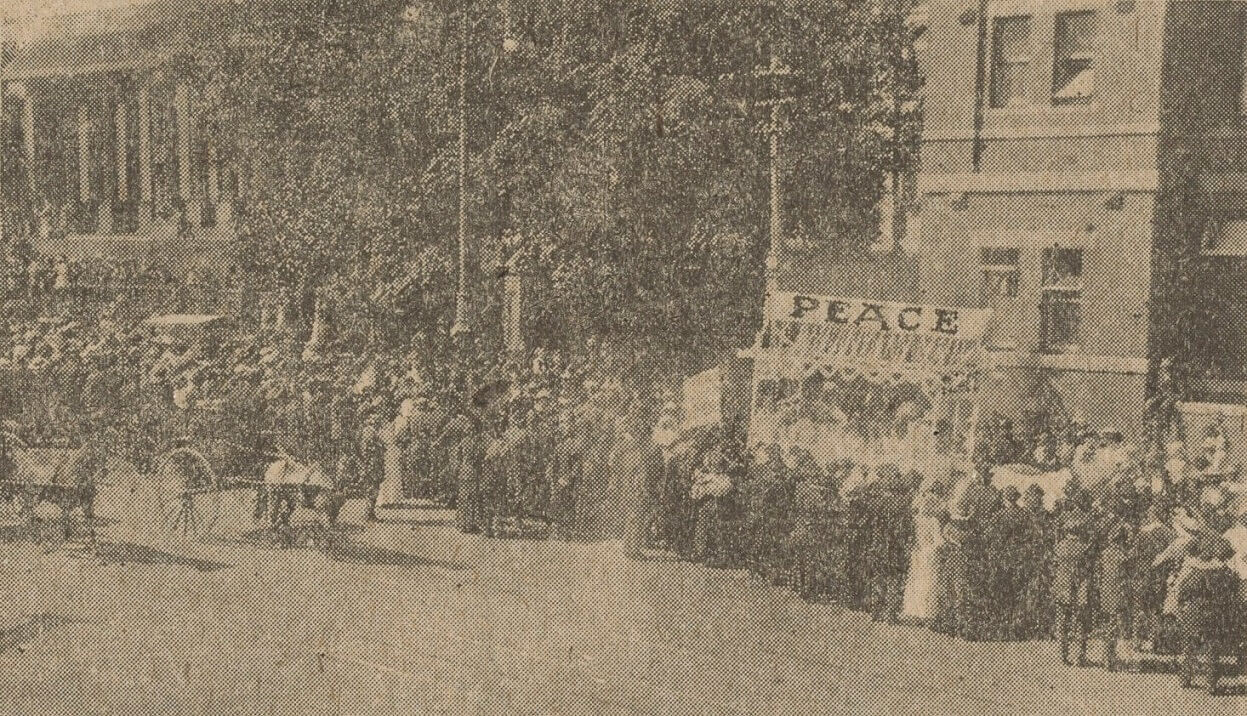Women played a central role in the conscription campaigns. Feminist Vida Goldstein later commented that conscription politicised Australian women more than any other issue. As participants they were active on both sides. Mainstream and conservative women's organisations, like the National Council of Women or the Australian Women's National League, supported conscription, distributing leaflets and organising meetings for the pro-conscription cause. Labour women's groups, socialists and radical feminists like the Women's Peace Army, formed by Vida Goldstein and Adela Pankhurst, campaigned against.
Appealing to women voters
Women featured prominently in the propaganda campaigns of both sides. Emotive leaflets and posters appealed to women as mothers, wives and sisters of soldiers or potential soldiers. The 'Yes' side appealed to women's loyalty and pride and did not mince words. In a special Manifesto 'To the Women of Australia' issued in 1916 Hughes demanded: 'Will you be the proud mothers of a nation of heroes, or stand dishonoured as the mothers of a race of degenerates?' It was extreme language suggesting a stark choice. In response the 'No' side appealed to women's maternal instincts and to their sense of fairness. The hugely influential leaflet 'The Blood Vote' reminded women that in voting for conscription they might send innocent young men, other women's sons, to their doom. The chorus of the popular anti-conscription (and anti-war) song 'I didn't raise my son to be a soldier' said much the same thing:
I didn't raise my son to be a soldier,
I brought him up to be my pride and joy:
Who dares to put a musket on his shoulder
To kill some other mother's darling boy?
Propaganda leaflets were sometimes mirror images of each other. The poster 'Vote No Mum they'll take Dad next', was replicated almost exactly in the pro-conscription version 'Vote Yes Mum or else they'll take Dad'. The image of the woman appears to be identical in each.
As citizens, with a full franchise, Australian women were a relatively new force to be reckoned with, and both sides in the conscription debate were acutely aware of it.
Women as symbols
Women were represented in many other ways in conscription imagery by both sides in the conscription debate. The 'Yes' side and more general pro-enlistment material often included graphic images of women as helpless victims of war. Women's bodies were also used as symbols for countries. This was an era in which countries were often depicted in allegorical form as female figures, and 'poor little Belgium' was almost invariably presented in this way - ravaged (and by implication ravished) by the beastly Hun. It was a short step to imagining Australia and Australian women subjected to the same brutal treatment should the British not prevail.
Labour imagery had its own version of woman as victim, but more often she was the victim of class oppression at home - shown working her fingers to the bone for low wages, or starving, surrounded by clamouring, hungry children, as in the cartoon 'The Referendums: Will they never come?', drawn by Rob Shaw.
Occasionally an alternate image referencing the 'new woman' of the twentieth century appeared. In 'the Women's Big Gun' three capable women, in modern no-nonsense dress, fire a shell marked 'Yes' from the 'Reinforcements Vote' canon.
A similar depiction of an armed modern woman appears in 'Stand by your own'. The women in these cartoons are active and determined, with no hint of the victim image used elsewhere.
Radical women
Feminist organisations were divided when war broke out. Many supported the war, although their attitude to conscription is not so clear. The National Council of Women did support conscription and made it clear that Vida Goldstein's pacifism was no longer welcome. Goldstein concentrated her efforts and considerable talents elsewhere. With Adela Pankhurst and Cecilia John she established the Women's Peace Army, touring to Sydney and Brisbane in 1915 to open branches there. John was a fine contralto and often opened these meetings by singing 'I didn't raise my son to be a soldier', a rousing anti-war song that was later banned under wartime censorship regulations. Goldstein campaigned vigorously against conscription. With Pankhurst, John and Jennie Baines she convened meetings, addressed large crowds and led peace marches, attracting large crowds. She also learned to deal with hecklers in the crowd, some of whom could be violent. Both Goldstein and Pankhurst were attacked during or after meetings, sometimes by enraged returned soldiers. It was observed that the police rarely intervened.
Goldstein intended her meetings and marches to be peaceable and orderly. More violent demonstrations were organised by socialist feminists Adela Pankhurst and Jennie Baines in protest at rising food prices and shortages. On several occasions in 1917 these food demonstrations turned into riots, with window breaking and violent scuffles with police. Both Pankhurst and Baines were arrested and goaled. Pankhurst was defiant. Police interviews recorded her declaring:
The high prices caused the recent demonstrations. Parliament will do nothing and it is left to ourselves. We have only one course left open and that is to demonstrate. I am not afraid to fight even if it does come to the destruction of property.
Hughes described Pankhurst as 'a damned nuisance' and considered deporting her (she was a British citizen), but in the end she was goaled and not released until after the second referendum in 1917. In response to a petition seeking her release and signed by many thousands of people, Hughes reputedly offered to release Pankhurst on condition that she did not speak in public. She refused and served her sentence.
Women and the conscription vote
Although there is no way of knowing how women voted, many at the time assumed that a majority voted against conscription. Hughes certainly attributed the loss of the referendums to a combination of the Irish, German Australians (those who were still allowed to vote), the Wobblies and women. Others thought that Hughes himself was at least partially to blame, citing his extreme rhetoric and blatant suppression of all opposition, which offended even his supporters.
Further reading
Patricia Grimshaw, Marilyn Lake, Ann McGrath & Marian Quartly Creating A Nation, 1788-1990 Ringwood, McPhee Gribble, 1994
Marilyn Lake Getting Equal: The History of Australian Feminism St Leonards, Allen & Unwin, 1999
Marian Quartly & Judith Smart Respectable Radicals: A History of the National Council of Women, Australia 1896-2006 Clayton, Monash University Publishing, 2015
Judith Smart 'A divided national capital: Melbourne in the Great War', The La Trobe Journal, no. 96, September 2015, pp. 28-58
Judith Smart 'Feminists, food and the fair price: the cost of living demonstrations in Melbourne, August-September 1917', Labour History, no. 50, May 1986
Important Women in the conscription debate:
Adela Pankhurst (Walsh)
Cecilia Annie John
Jennie Baines
Vida Goldstein


